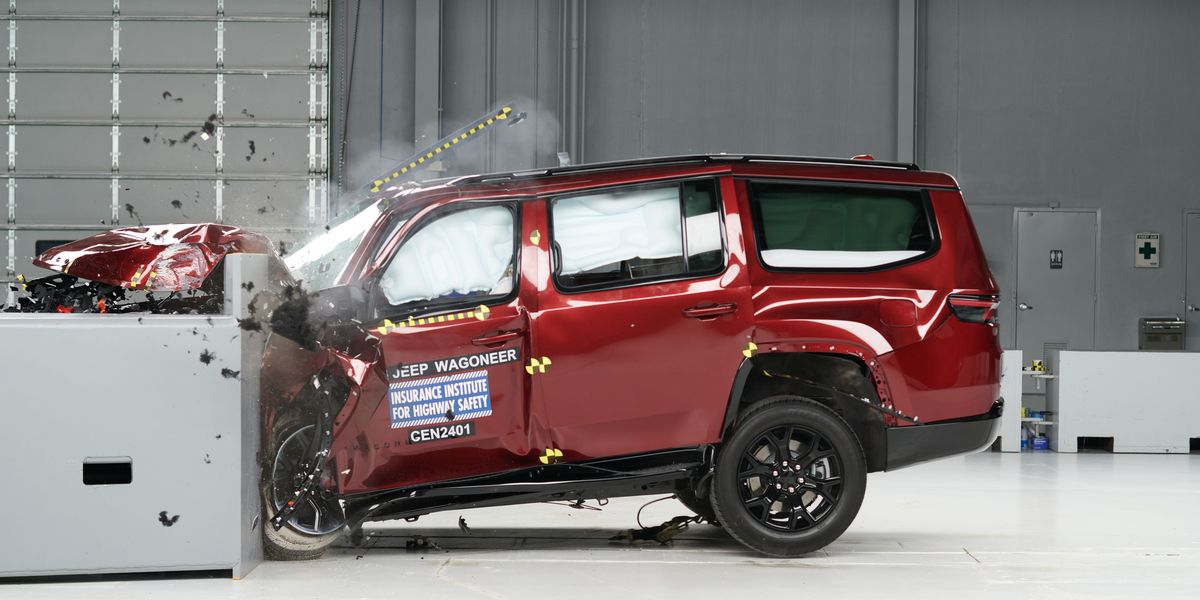
POPULAR LARGE SUVS 'LAG BEHIND' ON SAFETY STANDARDS, JEEP WAGONEER SCORES BEST, IIHS SAYS
Large SUVs are a consumer favorite for their passenger capacity, towing abilities, and comfort, but recent tests by the Insurance Institute for Highway Safety show room for improvement on key safety issues. The organization tested three popular large SUV models—the Jeep Wagoneer, the Chevrolet Tahoe, and the Ford Expedition—and named the Wagoneer the leader of the pack in terms of crashworthiness and crash avoidance, but emphasized a need for improvement in protections for back-seat passengers.
“These discouraging results show that some popular vehicles still lag behind in meeting the most advanced safety standards,” said Raul Arbelaez, vice president of the Institute’s Vehicle Research Center. “The good news is that the top performer in this class proves that automakers can readily address these problems.”
In the small overlap front evaluation, the Wagoneer earned a “good” rating for keeping the driver and front passenger "survival space" maintained in tests on both sides. The Tahoe struggled with risk of lower leg injuries with substantial intrusion into the footwell on both the driver and passenger side tests but maintained adequate survival space otherwise, earning it an “acceptable” rating. Testing was conducted on 2023 models, but the rating also applies to 2024 models.
The Expedition collapsed in this test in terms of both ratings and structure—IIHS observed partial detachment of the steering column from the instrument panel, separation of the A-pillar from the rocker panel on both sides, and excessive footwell intrusion on the driver’s side with intrusion to a lesser degree on the passenger side.
All three vehicles earned a “good” rating in the updated side test and in the original moderate overlap front evaluation, which considers the safety of front seat occupants in the case of a frontal offset crash. According to the IIHS, performance in this test has improved greatly for all vehicles since the test was first introduced in 2003. However, these protections have not extended to rear seat occupants, so in 2022 the IIHS introduced an updated version of the test that takes the safety of the rear seat occupants into account.
All three large SUVs struggled with this updated test, with the Wagoneer and Expedition earning marginal ratings for fairly high risk of chest injury to the second-row passenger from seat belt force. The Tahoe earned a “poor” rating for high risk of head or neck injuries and potential for abdominal injuries caused by the movement of the lap belt from the ideal position on the position in addition to risk of chest injuries. Concerns for back-seat passengers continue in the seat belt reminder test, as the IIHS found that the Wagoneer and Tahoe lack reminders for back-seat occupants. The Expedition earned a “good” rating.
This is obviously worrying for any type of vehicle, but as the IIHS notes in its report, large SUVs are often used to haul larger numbers of people.
The Wagoneer and Expedition performed well in the pedestrian crash avoidance evaluation, but the Tahoe struggled with the nighttime pedestrian scenarios. The IIHS suggests that its “marginal” rating in this test could be connected to its “poor”-rated headlights. The Tahoe’s low beams fail to properly illuminate the right side of straightaways, and the pedestrian dummy enters the test track from the right.
“Effective pedestrian collision avoidance systems are important for all vehicle classes, but for large SUVs like these, they are especially important because our research shows that when they strike pedestrians, they are more likely to cause fatal injuries,” says Arbelaez.
The Jeep Wagoneer performed the best of the three models and earned an IIHS 2024 Top Safety Pick award. It fell short of the highest-tier Top Safety Pick+ award due to lack of protections for the rear-seat occupants.
Looking to purchase a car? Find your match on the MSN Autos Marketplace 2024-06-06T20:48:02Z dg43tfdfdgfd